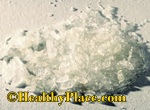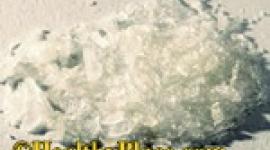Crystal Meth Produces Schizophrenia-Like Symptoms

Jake remembers the first time he saw the army people. High on crystal meth, he was well into his third day without sleep. Along with the boundless energy and heightened sense of alertness came the mind-bending hallucinations.
"One day I was so delusional... There were these trees on top of this overpass, and they looked like army people, dressed up with guns, marching down," the 19-year-old says between faint smiles and sips of strong coffee. "It was in the middle of the day, and I asked this truck driver, 'What's with all those army people?' He just looked at me. He was, like, 'What?' It was actually fun for me. I enjoyed the hallucinations."
But Jake started to notice that those visions kept happening even when he wasn't using meth. That's when he started getting scared.
"When the symptoms don't go away after you do it, it's no fun. That's when you know you're kinda hooped."
Jake is sitting in a hotel coffee shop in Tsawwassen on a deadly hot summer morning. He's just called local psychiatrist Bill MacEwan, asking for a refill of his antipsychotic and antidepressant medication. He'll take anything to counter the paranoia and delusions that continue to poison his thinking. Jake wasn't always so anxious. But that was years ago before he started using crystal meth.
The soft-spoken youth started using cocaine when he was 13. He switched to meth at 16, looking for something more powerful, a high that would enable him to stay up for parties that lasted days. That's one of meth's draws: you don't sleep. Then there's the hallucinatory effect. Jake would think a group of people was standing in front of him. He'd walk up to them, only to see the figures dissolve before his eyes into the bushes they really were.
Wearing a baseball cap, baggy pants, and loose shirt, Jake shifts his tired chestnut eyes away when he talks about his methamphetamine addiction. He doesn't want his name printed, although his parents and friends are well aware of the dark place he's in.
"The paranoia kicked in," Jake says. "I'd be so lonely and paranoid. It was a horrible feeling....I'd be looking out my window every five minutes to see if someone was out there. The trees I had always seen looked like people. I was so freaked out one night; I swear to God there were people out there. I hopped out my window in my boxer shorts looking for these people. I couldn't find them, so I got dressed and walked around the block looking for people in bushes. Thank God my parents caught on."
Meth is an extremely dangerous drug. It's cheap, highly addictive, easily accessible, and can be made at home, providing you have toxic chemicals like Drano and battery acid on hand. It can cause structural changes to the brain and induce psychotic symptoms that resemble those of schizophrenia: paranoia, disorganized thinking, delusions, and impaired memory. In some people, those effects will never go away, even long after they stop using.
It's also Vancouver's new demon.
The city's problem is so extreme that last November, on their own initiative, about 120 people from a vast range of professions and interests formed a group called the Methamphetamine Response Committee. It consists of psychiatrists, doctors, nurses, social workers, cops, and bureaucrats. There are representatives from high schools, custody centers, and safe homes, and users themselves. They all say meth use in town has risen dramatically over the last two years. And they're worried.
If the very existence of MARC doesn't speak to the urgency of Vancouver's problem, perhaps Steven Smith does. He's program coordinator of Dusk to Dawn, the street-youth resource center run by Family Services of Greater Vancouver. It's located in a rundown building at the back of St. Paul's Hospital and offers food, showers, and lockers for kids under 22. Teens can't use drugs in the center, but they're not turned away if they're high.
"Every single social-services agency has had to sit down in the last year and say, 'Meth has affected us. We have to talk about this,'" Smith explains in his office. "Everyone's on a fast-track learning curve. There's not a whole lot of information out there. There's no denying there's a meth epidemic, and we don't have the resources to address it. I think it caught everyone by surprise."
Meth came to prominence during the Second World War, when Japan, Germany, and the United States gave the drug to military personnel to increase endurance. Later, doctors prescribed it to treat depression, obesity, and heroin addiction. Illicit laboratories emerged in San Francisco in the 1960s, and from there it spread up and down the Pacific Coast. In the '80s came a new method of the drug's production, which led to crystal meth, a crystallized, smokable, and even more potent form of MA. Now, no city or town seems free of meth's tentacles. News stories are emerging about the drug's prevalence in places like Smoky Lake, Alberta; New York City; and the state of Hawaii.
According to the World Health Organization, methamphetamine is the most widely used illicit drug in the world after cannabis.
On local turf, there are countless youths who hang out downtown, like Jake used to, and spend as little as $5 for a high whose effects can last days. The Granville-Davie corridor is notorious for meth. It's the drug of choice for street kids: because it keeps users awake, they can guard their stuff at night; the drug also saps their desire to eat, which is convenient for those with no cash for food.
Although it may have gained popularity at raves, meth has moved well beyond that culture. This doesn't mean ravers aren't still using it--they might just not know it. Analysis by the RCMP's Vancouver-based drug-awareness program shows that almost 60 percent of ecstasy-like pills seized locally contain meth. The tablets, a random and dizzying concoction of chemicals, often contain such additional ingredients as cocaine, ephedrine, pseudoephedrine, and ketamine.
According to the Pacific Community Resources Society's 2002 "Lower Mainland Drug Use Survey", which interviewed about 2,000 youth aged 12 to 24, 19 percent had tried meth and nearly eight percent had used it within the past 30 days. The average age of first use was 14.5, and 45 percent of respondents said they could obtain the drug within 24 hours. Family Services of Greater Vancouver reported that in a six-month period in 2001, 14 to 34 youths sought detox for crystal meth. A year later, that figure jumped to 32 to 59 for the same period.
MARC members note that some adolescent girls are taking meth to lose weight, ending up not just skinny but skeletal. It's increasingly popular among the gay/bisexual/lesbian/transgendered community, and even with so-called soccer moms, some of whom take it to keep up with the demands of working and parenting. There are also stories of everyone from lawyers to software developers to longshoremen using meth.
A SYNTHETIC CENTRAL-nervous-system stimulant, meth increases the stimulation of dopamine, serotonin, and norepinephrine receptors in the brain. It can be swallowed, smoked, injected, or snorted. It provides a sense of focus and euphoria. Meth can cause hallucinations like the ones Jake described; users may also hear voices telling them to harm themselves or others or think people are following them. Coming down, users often experience an intense craving for the drug, anxiety, confusion, fatigue, headaches, and profound depression. They may be irritable, unpredictable, and suddenly violent.
"Aggression wasn't really a problem on the streets a few years ago," Smith says. "You need a whole new bag of tricks dealing with kids on crystal meth. Psychosis is one thing, but drug-induced psychosis is another."
Drug-induced psychosis is what interests Bill MacEwan. He started the Fraser Health Authority's Early Psychosis Program (www.psychosissucks.ca/) and, like so many other health professionals, has been seeing more and more kids on meth.
"I have patients who are 16 years old, in high school, who are psychotic," MacEwan says at a downtown restaurant. "They hear voices when they're partying, but those voices haven't gone away. It's very frightening, and the numbers are rapidly rising. It's not like cocaine or heroin...Methamphetamine causes symptoms that are almost exactly like [those of] schizophrenia."
What puzzles people like MacEwan is this: does crystal meth trigger psychosis in those who are already prone to mental illness (perhaps schizophrenia runs in the family), or does its use cause psychosis? It's a classic chicken-or-the-egg mystery.
A 2001 publication by the WHO, "Systematic Review of Treatment for Amphetamine-Related Disorders", found that five to 15 percent of meth users who develop a related psychosis fail to recover completely. Most users, the organization also reports, become psychotic within a week after continuous meth administration.
Making matters worse is that users who need medical help tend to fall through the cracks. "What do we do with the kid who's psychotic on the street?" asks Dr. Ian Martin, who splits his time between Vancouver Hospital, Dusk to Dawn, and Three Bridges Health Clinic. That clinic (1292 Hornby Street) is located in the heart of the Vancouver's crystal-meth central. He sees kids who snort meth, "hoop" it (insert it rectally), or "parachute" it (wrap it in a rolling paper and swallow it).
Those who have hit the bottom are often stuck there, Martin explains in a West End coffee shop. If a user in a psychotic state goes to emergency, he'll likely be sent right back out a few hours later because he's high. But most detox centers and mental-health organizations lack the resources and knowledge to handle meth-induced psychosis. In response, Martin has started giving seminars to health professionals on how to deal with users. (He also formed a crystal-meth-anonymous group, which meets every Friday at Three Bridges [604-633-4242].)
"There may be tactile hallucinations; they [users] have a sense of bugs crawling on their skin," Martin says. "They'll say, 'Look doc, it's right here,' and they're pointing to a hair on their arm, thinking it's a spider. They think they have scabies so they will pick at their skin."
Consequently, users are prone to skin infections. They're also susceptible to tooth decay. Users grind their teeth, and the drug decreases the saliva's pH level, allowing more bacteria to grow in the mouth. "I had one 21-year-old patient who had had all her teeth taken out. They were all rotten."
When the high starts to fade, the accompanying depression can be severe to the point of suicide. What also distresses Martin is that meth use significantly boosts the chances of contracting HIV, AIDS, and other sexually transmitted illnesses. The drug delays ejaculation, often leading to rougher sex as a result. (Infection spreads easily when the skin is torn.) "And if someone's high, they might not engage in safe sex," Martin says.
He notes that even though the amount of anecdotal evidence related to meth is staggering, more research is needed. But getting hard facts can be tough. It's difficult to get people with an addiction and a mental illness to take medication regularly and comply with doctors' orders. "If they get better, we never see them again. If they get a lot worse, we never see them again," Martin says.
In 2002, UCLA School of Medicine neurologist Linda Chang published "Perfusion MRI and Computerized Cognitive Test Abnormalities in Abstinent Methamphetamine Users" in Psychiatry Research Neuroimaging. The study found that ex-users were up to 30 percent slower to complete tasks requiring working memory than nonusers.
"The slower reaction times on the computerized tasks...are suggestive of subclinical Parkinsonism in individuals who abused meth," Chang's study stated.
DIFFICULTY REMEMBERING things is a consequence of meth use to which 18-year-old Vancouver resident Kasper can testify. Although he quit meth more than a year ago, he says his memory is shot. He can't recall anything he learned in school.
Wearing a studded leather jacket, a ring in his nose, and black from head to toe, the burly youth looks older than his years. When he's not at his Chinatown apartment taking care of his pet rat, Shithead, he hangs around at Dusk to Dawn. He started using meth when his mom kicked him out of the house; it was the middle of winter and his brother suggested the drug to stay warm.
"It had a crab-apple taste, like crab apples right off the trees," the amiable Kasper says at the youth center. "I liked it because of its taste. If you like it, you want to do it more and more and more. The next thing I know, I'm in Vancouver making it in my hotel."
He continued using for two or three years--he couldn't keep track of what year it was--until, after so much sleep deprivation, he hit a breaking point.
"I put an eighth of weed and a point of crystal meth on the table," he says. "I thought, 'Do I smoke this weed and get baked out of my fucking tree, or do I smoke this meth and stay up for two days and do something I think is constructive but that's just a big fucking waste of my time?' I ended up flushing the meth down the toilet and smoking myself stupid. When I see people doing meth now, I just tell them to do that.
"Getting drunk and smoking pot is a lot better than crystal meth. I've seen people make it in their bathtubs. They pour Drano, ammonia, battery acid, and all this other crap in there. You end up coughing up blood and puking blood up. I'd recommend heroin a lot more than crystal meth. And I did not enjoy heroin."
Kasper isn't exaggerating when he says crystal meth is full of crap. Mixed together, the substances can explode or give off toxic fumes that attack mucous membranes. Yet the drug isn't that hard to make. Mom-and-pop labs can be set up in high-rise apartments, storage sheds, and basements. Recipes downloaded from the Internet call for ephedrine (found in cold medication and decongestants), rubbing alcohol, methanol, lithium, and ammonia, among other ingredients. Take this excerpt from an online source:
"Dilute HCl--also called Muriatic acid--can be obtained from hardware stores, in the pool section. NaOH--also called lye--can be obtained from supermarkets in the 'drain cleaner' section....Ethyl Ether--aka Diethyl Ether--Et-O-Et--can be obtained from engine starting fluid...Desoxyephedrine--can be obtained from 'VICKS' nasal inhalers...Distilled water--it's really cheap, so you have no reason to use the nasty stuff from the tap. Do things right."
Given the prevalence of meth in Vancouver, the city is a prime spot for more research. UBC clinical psychologist Tania Lecomte is applying for funding from the Canadian Institutes of Health Research to study methamphetamine and psychosis. Her team will do magnetic-resonance-imaging scans to see if there are structural changes or neural damage in meth users' brains; it will also explore psychosocial rehabilitation.
"I worked in first-episode psychosis for a while, and I would work with clients and do diagnostic interviews," Lecomte says in a phone interview. "In a lot of cases, crystal meth is what caused them to come to the hospital. It seems to have totally changed the personality and behavior of street youth."
The Vancouver Agreement (a partnership of the federal, provincial, and local governments to foster the city's development) has funded a small study to get input from users. Theo Rosenfeld, who runs Pala Community Development, which supports harm reduction, is conducting the review. In a phone interview, he explains he has tried meth and although he never got hooked, he can see why so many kids are.
"Given the housing options, if I didn't have a place to sleep I don't know if I could be off speed," Rosenfeld says. "It feels as if life is worth living...You're not going to give that up if you've never felt that way before."
Rosenfeld says he was surprised at MARC's efficiency during that first November meeting.
"It was the most intelligent, collaborative response to a drug issue I've ever worked in, in any city I've ever been," he remarks. "Usually these meetings are full of catcalling, booing, and hissing. People are genuinely concerned."
One of the most pressing concerns is treatment. A combination of antidepressant and antipsychotic medication seems to have promising results, but other possibilities need investigation. Then there's the lack of funding, resources, and staff, thanks largely to government cutbacks.
"If you cut off your hand, you go to the hospital and they'll fix it. I'd like to see [drug] treatment work like that," Dusk to Dawn's Steven Smith says. "Youth should be able to say, 'I need help and I need it now.'...It's a really hard drug to quit. They need a lot of support and care, and it's just not there."
There are 10 beds allocated to youth detox services in Vancouver.
SINCE NOVEMBER, MARC members have formed subcommittees that meet every two months. Jennifer Vornbrock, who's heading the group's treatment-and-prevention arm, says the next step is to see what can be done with existing resources. Because those involved recognize the seriousness of Vancouver's problem, there's no room for politics or self-interest.
"This isn't the speed your parents took," says Vornbrock, the Vancouver Coastal Health Authority's manager of youth, women's, and population health. "It's 10 percent ephedrine and 90 percent ammonia. It's not a drug you want to play around with."
Back in Tsawwassen, Jake has no shortage of tales about the damage crystal meth has done to his own life. He sold a new truck for a pitiful sum to get drug money, dropped out of school in Grade 10, and has essentially lost his youth.
"When we were kids, we used to have fun," Jake says. "Now I've lost all my friends to drugs. You can't keep friends because you're antisocial and paranoid."
Perhaps the lingering delusions are the saddest part of Jake's story. Not even 20, he can't make it through a day without antipsychotics.
"They calm me down," he says. "I thought I could detox on my own. Now it's about staying clean one day at a time. It's about staying alive."
Story by: By Gail Johnson
Reprinted with permission from the Georgia Straight newspaper
APA Reference
Staff, H.
(2007, March 3). Crystal Meth Produces Schizophrenia-Like Symptoms, HealthyPlace. Retrieved
on 2025, July 18 from https://www.healthyplace.com/thought-disorders/schizophrenia-articles/dark-crystal



